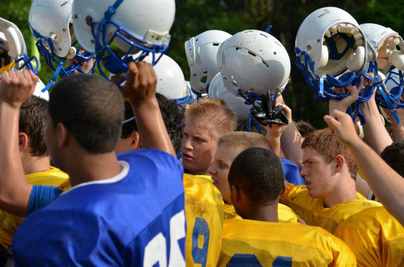 By William Mitchell,
By William Mitchell,
Head Coach,
Lewisville High School (SC)
As we all know, the game changes drastically as the offense approaches the goal line. Nearly every offensive coordinator I know changes the way their offense use formations and call plays due to both the proximity of the goal and the decreased vertical space that they have to work with. Conversely, experiences have shown me that defensive coordinators are mush less apt to change in this area of the field. Sure most of us have a goal line package that may switch to man coverage or add a defensive lineman, but most coaches still stick with their base stuff. This presents a variety of issues that can prove costly in the most important moments of the game.
It is for that reason that we have shifted the focus of our goal line defense from being a defensive adjustment to becoming a special team. Here are a few reasons for that change:
- No one is off-limits to this unit personnel-wise. If I need the starting tailback at a corner and I need the starting quarterback coming off of the edge, then I get them. Most of our normal defensive package is based on speed, quickness, & multiplicity, but we are different in goal line. By making our goal line unit a completely separate group, I can add the size that we would sometimes like to get in there in short yardage and I can add other athletes whose skill sets fit what we want to accomplish.
- We can create a separate mindset specifically for that unit. We really push being great on the goal line as being a key to our program. We attach a great deal of pride to getting on this unit, and players on both sides of the ball want to play on this unit.
- If we are in goal line, it usually means that things have not gone so great defensively. By running a separate unit onto the field (even if 7 or 8 of the players are on 1st Defense anyway), it creates a little bit of a "fresh start" mentality and gives us a confidence boost.
As is the case with many special teams concepts, simplicity and flexibility is key. Since we are subbing in players who may not be on defense full time and who may not be expecting to enter the game at that moment. If we have a turnover inside our own 10 and I need to call goal line defense unexpectedly, our scheme is simple enough that the players know what to do even if they are surprised. We also think that this approach, if executed correctly of course, builds the players confidence in the scheme. By keeping simple and flexible, the players always know exactly where to be regardless of the formation thus allowing them to play faster and more confidently.
Gorilla Personnel Types
Our scheme is a mix of several things the coaching staff has encountered, but a large base of the scheme comes from Bellevue High School in Washington. They are the team that broke De La Salle's winning streak. These are the positions and what we look for to fill them:
- Two NOSE GUARDS - Quickness is a top priority. Wrestlers, running backs, Strong Safeties.
- Two ENDS - Preferably our two best defensive linemen.....size & strength needs to be a little more of a factor here.
- Two EDGES - The two best athletes on the team. Option quarterback, point guard on basketball team, change of direction ability is huge. Speed is important, size is not.
- Two LINEBACKERS - the best two linebackers, at least one must be able to cover man to man.
- Three DEFENSIVE BACKS - must be able to lock up man coverage for at least 2 seconds.
We call our goal line package GORILLA (as in 800lb Gorilla). Since we went to this package three seasons ago, we have made 15 successful stands in 28 opportunities. These are our alignments in GORILLA:









